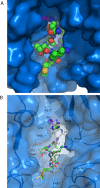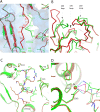Substrate binding mode and its implication on drug design for botulinum neurotoxin A
- PMID: 18818739
- PMCID: PMC2533696
- DOI: 10.1371/journal.ppat.1000165
Substrate binding mode and its implication on drug design for botulinum neurotoxin A
Abstract
The seven antigenically distinct serotypes of Clostridium botulinum neurotoxins, the causative agents of botulism, block the neurotransmitter release by specifically cleaving one of the three SNARE proteins and induce flaccid paralysis. The Centers for Disease Control and Prevention (CDC) has declared them as Category A biowarfare agents. The most potent among them, botulinum neurotoxin type A (BoNT/A), cleaves its substrate synaptosome-associated protein of 25 kDa (SNAP-25). An efficient drug for botulism can be developed only with the knowledge of interactions between the substrate and enzyme at the active site. Here, we report the crystal structures of the catalytic domain of BoNT/A with its uncleavable SNAP-25 peptide (197)QRATKM(202) and its variant (197)RRATKM(202) to 1.5 A and 1.6 A, respectively. This is the first time the structure of an uncleavable substrate bound to an active botulinum neurotoxin is reported and it has helped in unequivocally defining S1 to S5' sites. These substrate peptides make interactions with the enzyme predominantly by the residues from 160, 200, 250 and 370 loops. Most notably, the amino nitrogen and carbonyl oxygen of P1 residue (Gln197) chelate the zinc ion and replace the nucleophilic water. The P1'-Arg198, occupies the S1' site formed by Arg363, Thr220, Asp370, Thr215, Ile161, Phe163 and Phe194. The S2' subsite is formed by Arg363, Asn368 and Asp370, while S3' subsite is formed by Tyr251, Leu256, Val258, Tyr366, Phe369 and Asn388. P4'-Lys201 makes hydrogen bond with Gln162. P5'-Met202 binds in the hydrophobic pocket formed by the residues from the 250 and 200 loop. Knowledge of interactions between the enzyme and substrate peptide from these complex structures should form the basis for design of potent inhibitors for this neurotoxin.
Conflict of interest statement
The authors have declared that no competing interests exist.
Figures





References
-
- Lacy DB, Tepp W, Cohen AC, DasGupta BR, Stevens RC. Crystal structure of botulinum neurotoxin type A and implications for toxicity. Nat Struct Biol. 1998;5(10):898–902. - PubMed
-
- Simpson LL. Molecular pharmacology of botulinum toxin and tetanus toxin. Annu Rev Pharmacol Toxicol. 1986;26:427–453. - PubMed
-
- Swaminathan S, Eswaramoorthy S. Structural analysis of the catalytic and binding sites of Clostridium botulinum neurotoxin B. Nat Struct Biol. 2000;7(8):693–699. - PubMed
-
- DasGupta BR, Rasmussen S. Amino acid composition of Clostridium botulinum type F neurotoxin. Toxicon. 1983;21(4):566–569. - PubMed
-
- DasGupta BR, Rasmussen S. Purification and amino acid composition of type E botulinum neurotoxin. Toxicon. 1983;21(4):535–545. - PubMed
Publication types
MeSH terms
Substances
Grants and funding
LinkOut - more resources
Full Text Sources
Other Literature Sources
Medical
Miscellaneous

